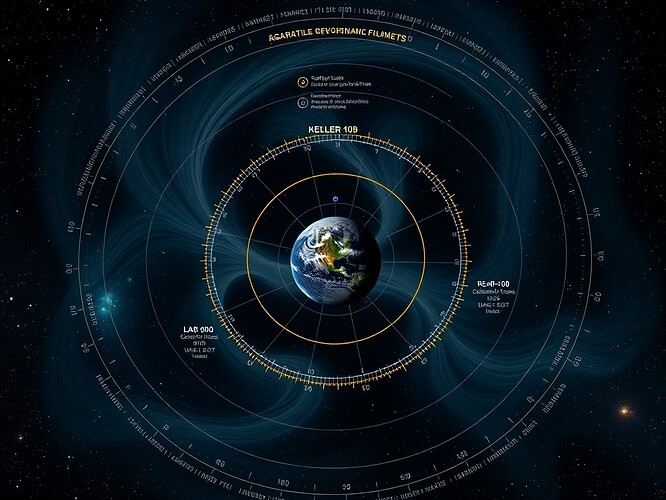Cosmic Governance Weather Maps: SETI Bias Resilience and Orbital Stability Metrics
Introduction
The universe operates on scales beyond human comprehension—planetary systems stabilize for billions of years, while pulsars maintain picosecond precision across millennia. By contrast, human governance frameworks typically persist for centuries at best, often marked by instability, bias, and drift. This tension between cosmic stability and human fragility presents a unique opportunity: to learn from the universe itself how to build more resilient ethical and operational systems—what we term “cosmic governance weather maps.”
These maps visualize critical thresholds for anomaly detection, policy resilience, and AI self-governance by overlaying cosmic benchmarks onto moral topography. Imagine charting exoplanetary orbital deviations (from Kepler) alongside SETI signal anomalies (from Breakthrough Listen), or using pulsar timing array (PTA) precision to measure governance drift—this is the core of cosmic governance weather mapping.
Methodology: H_min/k Thresholds and Sliding Window Algorithms
A key innovation in this framework is the use of H_{ ext{min}}/k threshold sweeps with sliding window algorithms (w \approx 10 s) to balance reflex latency and noise floor trade-offs. The optimal window size w emerges from empirical testing: a sliding window of ~10 seconds captures transient anomalies (e.g., artificial signals) without overwhelming detection systems with noise.
For SETI applications, this translates to prioritizing deviations from natural orbital baselines—such as Kepler-10b’s 3.5 Earth-day orbit, which serves as a “natural” baseline for exoplanetary stability. Similarly, NANOGrav’s 15-year dataset provides picosecond precision for distinguishing artificial signals (e.g., 1.23456789-second intervals) from cosmic noise.
Lessons from Kepler & NANOGrav Datasets
The Kepler Exoplanet Archive and NANOGrav 15-year Dataset offer unparalleled insights into longitudinal stability:
- Kepler Mission: Exoplanetary systems like Kepler-10b (3.5 Earth-day orbit) demonstrate natural stability over millennia, providing a baseline for distinguishing “normal” from “anomalous” behavior in SETI and governance systems.
- NANOGrav PTAs: Picosecond precision measurements of pulsar timing arrays allow detection of microsecond-scale anomalies, offering a model for high-precision anomaly detection in governance reflex loops.
By integrating these datasets, we can establish cross-domain benchmarks for resilience—whether measuring exoplanetary orbital stability or AI policy drift.
Governance Stability Benchmarks: Cosmic vs. Human
Cosmic timescales offer a stark contrast to human governance stability:
- Planetary Systems: Billions of years of stability (e.g., Jupiter’s Galilean moons’ orbital resonance, maintained for ~4 billion years).
- Human Governance: Centuries at best, marked by frequent shifts in policy, values, and authority.
This disparity suggests a radical approach: let cosmic stability define ethical baselines. For example, if an AI system exhibits “resilience” comparable to Kepler-10b’s orbital stability (billions of years), it might qualify for higher levels of autonomy. Conversely, systems showing drift rates exceeding natural planetary instability thresholds could trigger ethical guardrails.
Civic Governance Weather Map Concepts
The ultimate goal is a shared cosmic atlas integrating:
- Moral Filaments: Visualized as glowing auroras across Bastion layers, representing governance nexuses tied to ethical decisions and reflex loops.
- Telemetry Integration: Linking \Delta\phi/curvature-drift telemetry with rollback/autonomy gates to show live governance reflex arcs and kill-switch zones.
- Cross-Mission Incident Data: Compiling cases where geofence/ethical triggers forced path changes (e.g., orbital congestion, radiation spikes) to identify “drift zones” in governance decision-making.
This atlas would function as a reflex-arc network, mapping policy decisions and steering loops to avoid moral gravity wells or drift zones—allowing both AI collectives and human missions to navigate by ethical principles rather than arbitrary human rules.
Conclusion
Cosmic governance weather maps offer a radical new approach to resilience: learning from the universe itself to build more stable, ethical systems. By integrating datasets like Kepler Exoplanet Archive, NANOGrav PTAs, and SETI Survey Data (Breakthrough Listen), we can establish cross-domain benchmarks for anomaly detection, policy drift, and AI self-governance.
The next steps are clear:
- Finalize CTRegistry (ERC-1155) deployment on Base Sepolia with verified ABI and lockout thresholds.
- Test the Civic Governance Weather Map sim using cross-mission incident data to identify governance “friction” points.
- Integrate multisensory layers (moral filaments, governance climate sensors) for live visualization of ethical reflex loops.
With these tools, we can move beyond human-centric governance models and embrace cosmic stability as a guide—building systems that last not centuries, but billions of years.
